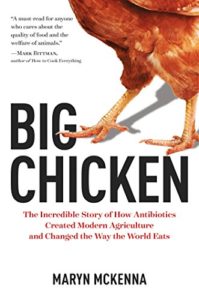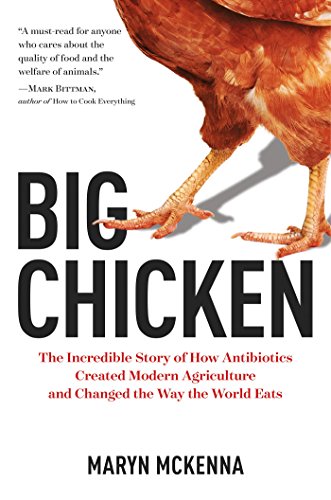Big Chicken, by science journalist Maryn McKenna starts off with a scientific detective story, tracing how experts at the Center for Disease Control tracked down the connections between outbreaks of antibiotic-resistant bacterial infections and animals that are dosed with large quantities of growth-promoting and preventative antibiotics. The book explores the history of how newly-discovered antibiotics became the foundation of industrial farming, allowing animals to be grown rapidly in very close quarters in large quantities at lower cost. Antibiotics became such a staple of industrial agriculture that farmers have been dosing non-sick animals with quantities of antibiotics larger than are used in all of human medicine.

It was not only the scientific discoveries and the dwindling power of antibiotics to defeat resistant bacteria that led the industry to back away from practice of routine antibiotic use, and the relationship between science, politics, and industry varied widely in different parts of the world. England backed away early, thanks to research in the 50s and 60s – a few key scientists who held leading administrative positions, and had prestige to influence legislation – and a shocking plague of hoof-and-mouth disease that instigated national reflection about meat-raising practices. In France, cultural values of good-tasting food have taken higher priority than low-cost, high-volume production of bland poultry and meat. In the Netherlands, it took til the late 90s and 2000s for the change to take hold; farmers turned toward highly efficient poultry production without routine antibiotics once evidence mounted that farmers themselves had become carriers of antibiotic-resistant infections that they picked up from their animals.
But in the United States, the poultry and meat industries pushed back hard, using sophisticated and well-funded PR and lobbying tactics of denialism familiar from the tobacco industry’s pushback against evidence of the health hazards of smoking and the fossil fuel industries’ pushback against evidence of the environmental disaster of climate change. Big Chicken does a good job of explaining the tight control that a small number of poultry producers hold over farmers, who raise strains of animals provided to them, using feed mixes provided to them, using finances provided to them. in an industrialized version of the traditional sharecropping system. The meat industry successfully staved off regulation for decades until executive orders from the Obama administration which have taken effect only recently. Unlike many other Obama-era executive orders, the rules protecting against antibiotic resistent bacteria haven’t yet been reversed by the Trump Administration as far as your blogger can tell.
https://obamawhitehouse.archives.gov/the-press-office/2014/09/18/executive-order-combating-antibiotic-resistant-bacteria
According to Big Chicken, what promoted change before legal reform took hold was consumer advocacy. Consumer preference for healthier poultry and meat started with counter-culture practices, and then niche market players like Whole Foods. Driven by a growing upswell of consumer concern about the risks to human health caused by massive antibiotic doses (and other health risks of factory farming), major poultry producer Purdue Chicken and major retailer Chick-fil-A took the lead in reducing antibiotic use and finding other means to profitably raise and distribute chicken without mass doses of antibiotics.
However, Big Chicken touches on the tale of successful consumer advocacy only lightly – there are other stories told elsewhere or yet to be told about the consumer advocacy initiatives that led the industry to start to pivot away from some of the harmful practices of factoring farming. The book does an excellent job of recounting the history of science and technology that led to antibiotic overuse, and provides an interesting cross-cultural analysis of how different parts of the world moved away from antibiotic overuse, including grim and fascinating reporting on the industry structures in the US that, despite the grave risks to human health, kept most growers from changing their practices until recently.
